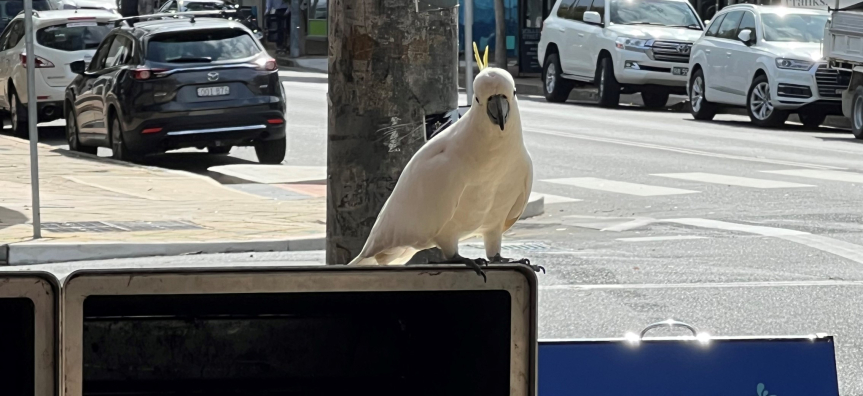From Avalon to Seaforth, a band of wily foragers have their eyes firmly fixed on your waste bins.
Small in stature, this feathered army and their scavenging antics are causing havoc across Northern Beaches suburbs. An ongoing citizen science project wants your help to monitor the mayhem, and at the same time help protect other threatened species.
We’re talking about sulphur-crested cockatoos. No stranger to our suburbs, these native white parrots have a distinctive loud screech, destructive bills and wily behaviour that has made them both loved and loathed.
They’re also smart. So much so, that some clever cockieys around Newport and Avalon shops have worked out how to open the waste bins to access the food scraps within. Shop owners have had enough, using weights to stop the crafty birds raiding their rubbish and creating mess.
Not surprisingly, bin opening is not a natural cockatoo behaviour. They’re small and armless creatures and the lids are heavy, but somehow, they’ve worked out a technique to access the tasty contraband.
How they’ve learnt these new skills has got scientists from the Clever Cockie Project ruffled, as they research how the birds develop new behaviours. Since 2018 they’ve been asking Sydney residents in their annual bin-opening survey to share evidence from within their communities to contribute to their research on cockatoo behaviour.
In the first year, the study identified only three southern Sydney suburbs with bin-lifting cockatoos. Two years later, it was forty-four and today the behaviour has spread to their cousins here in the north. Scientists have discovered that the birds are sharing these lid lifting skills with other flocks – who in turn imitate and adapt it - in a display of “social learning”.
This year, with lid-lifting on the rise locally, Council’s Bushland & Biodiversity team are appealing to residents to share their observations in the survey to help monitor the problem.
As well as impacting human habitats, sulphur-crested cockatoos are also threatening other bird species locally. They’re outcompeting our local native black cockatoos, including the endangered Glossy Black-Cockatoos for food and rare breeding hollows. They’re also to blame for spreading beak and feather disease amongst hollows and other species.
Visit the Clever Cockie annual bin-lifting website to fill out the survey and learn more.
Learn more about threatened species across Australia including the Glossy Black-Cockatoo.

Photo by Sonja Elwood

